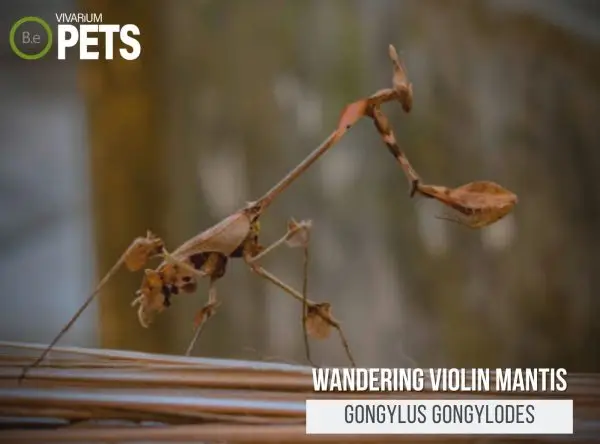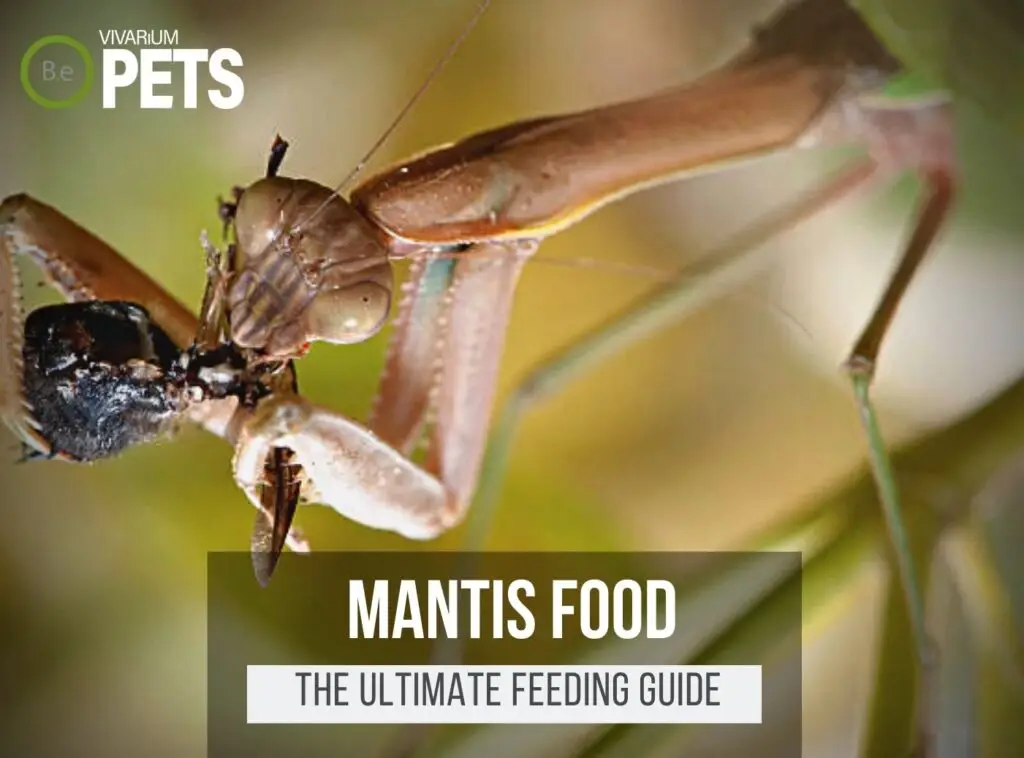Gongylus gongylodes, commonly referred to as the Wandering Violin Mantis, is a wildly creepy yet phenomenal mantis species that is popular among flower mantis keepers and hobbyists alike.
With its distinctive pattern, unusual shape, and unique behavior, this pet mantis is a fascinating insect to keep and care for.
In this guide, we will cover the basics of Wandering Violin Mantis care, including housing, feeding, and general maintenance.
Table Of Contents:
ToggleWhat Are Wandering Violin Mantis?
Gongylus gongylodes belong to the family Mantidae and are native to tropical regions of South India.
Their common name is thought to come from the striking violin-shaped body, although the colors and patterns on their bodies can vary greatly.
This species of praying mantis is known to be quite hardy and can tolerate a wide range of conditions, making them an ideal beginner pet for those interested in keeping exotic insects.
What Do Wandering Violin Mantis Look Like?
The Wandering Violin Mantis is one of the more unique species of mantis due to its distinct pattern resembling a violin.
It is typically found in a range of browns and greens with small black spots along its body.
It has long antennae and its eyes are shallow, curved, and placed farther back than those of other mantis species.
Gongylus gongylodes typically grow to a maximum length of around 3-5 inches.
The males are smaller than the females, a common trait among mantids, as well as having longer antennae and a more slender body.
It is an active species with a wide range of behaviors and is well known for its “hunching” when threatened.
Benefits Of Using Wandering Violin Mantis
Vivariums provide a great way for pet keepers and hobbyists to observe Wandering Violin Mantis in their natural environment, while also providing the insect with the space it needs to thrive.
These types of enclosures provide a self-contained safe environment that maintains the ideal temperature and moisture levels for the mantis while also providing visual stimulation and preventing escape.
Vivariums like a terrarium also provide more opportunities for natural behaviors, including foraging, mating, and egg-laying.
Additionally, due to their size, tanks can be moved conveniently from place to place, making them a great choice for people who are often traveling or have limited space.

Wandering Violin Mantis Facts
The Wandering Violin Mantis is a medium-sized species of mantis native to Southeast Asia, with adults reaching impressive lengths for mantids.
Their distinct pattern of alternating hues of color is striking and eye-catching, and their relatively docile temperament tends to make them a good choice for beginners.
These mantids have a lifespan of over a year and primarily feed on a variety of insects and spiders in the wild.
Breeding tends to take place during the cooler season, which is in spring and summer, and young mantis hatchlings should be separated as soon as possible.
Habitat
Gongylus gongylodes are native to Southern India and can mostly be found in forests and tropical rainforests.
When kept in the wild, Wandering Violin Mantises will construct a shelter by making a crease in a leaf, which they inhabit.
This allows them to remain well-concealed while they wait for their prey.
They also use this same technique when being kept as pets so it is important to create an appropriate environment with plenty of leaves, branches, and other hides.
Create the perfect home for your mantis with our Customizable Mantis Enclosure Kits, designed to meet all their habitat needs.
Diet
Wandering Violin Mantis is mainly opportunistic and insectivorous, feeding on insects such as grasshoppers, crickets, flies, and other soft-bodied insects.
In their natural environment, they feed on a variety of small insects during the day.
As nocturnal predators, they often perch on vegetation and foliage to wait for food to pass by.
When detected, they quickly react and grab their prey with their raptorial legs.
Temperament
Gongylus gongylodes are generally quite gentle and calm around humans, as they are non-aggressive by nature.
They are quite curious, and will often turn to look at humans or other animals interacting with them.
While they are unafraid to explore different objects, they are not known to be typically aggressive toward people or other animals.
However, like with any wild animal, if they are disturbed or feel threatened, the Wandering Violin Mantis may become defensive and may kick or bite as a means of self-defense.
It is therefore important to be respectful when interacting with these majestic creatures.
When around other animals, G. gongylodes should be kept in an enclosure to prevent them from escaping or coming into contact with other species.
While mantis species can live together harmoniously, it is typically not recommended as they have been known to fight and kill each other for food or territory.
Therefore, if you want to keep a Wandering Violin Mantis pet in the same enclosure as other animals, it is essential to make sure that each animal has enough space, food, and resources and that the environment is well-maintained.
Lifespan
The Wandering Violin Mantis has a relatively long lifespan compared to other species, usually lasting about one year to one and a half years from juvenile to adult (depending on environmental conditions).
The complete life cycle typically consists of an egg stage, 6 to 7 juvenile stages (in which molts of the external body occur), and 1 adult stage.
During the 6-7 juvenile stages, the mantis will grow larger and change its color patterns.
In the adult stage, Gongylus gongylodes will reach their full size and adult coloration.
Like most species, the age and size of Praying Mantis will affect their lifespan.
The mantis tends to live longer in captivity, under the right conditions, and with plenty of food.
To ensure a longer life for your Wandering Violin Mantis, provide a healthy and suitable environment and a well-rounded diet to maximize growth and health.
Breeding
Gongylus gongylodes is a solitary species, and the females of the species will aggressively attack and even kill others of its kind.
For this reason, it is best to keep only one Wandering Violin Mantis per enclosure.
When the male and female mantis are ready to mate, the male initiates courtship behavior.
He will wave his antennae and perform a ritualistic dance, standing with legs extended and wings spread wide as if to say “Here I am”.
If the female is receptive, she will accept the male’s advances and the pair will copulate.
After mating, the female must be provided with an adequate supply of food for sufficient nourishment of the eggs.
She will then lay an ootheca (or egg capsule) which usually contains dozens of eggs.
The ootheca will take up to 3 weeks to harden.
During this time, the female will remain with the egg capsule, protectively guarding it from predators.
When the eggs are ready to hatch, they will open and tiny mantis nymphs will emerge.
Where To Find Wandering Violin Mantis
Finding Gongylus gongylodes in the wild is not difficult; they are a species found throughout India and Bangladesh.
However, they are considered rare in some areas. If you’re looking for a Wandering Violin Mantis to buy, there are a few sources available.
Online pet stores stock these mantids and may ship directly to your address.
You can also look for local pet stores or hobbyist reptile shows, as they may have this mantis for sale from time to time.
When purchasing a Wandering Violin Mantis, make sure you inspect the insect before buying it.
Check for signs of parasites, disease, or injuries.
Also, try to purchase/adopt captive-bred mantis, as they are generally more healthy and have fewer chances of issues like parasites than wild-caught insects.
Wandering Violin Mantis Care
Gongylus gongylodes need an appropriately sized enclosure that is properly heated and humidified.
They should also be fed a steady supply of small, appropriately sized prey and cleaned regularly.
Breeding is also possible, although it requires extra attention and care.
Further, one should always be on the lookout for signs of illness in their appearance or behavior and take quick action if necessary.
Tank Requirements
When it comes to tank requirements for the Wandering Violin Mantis, it is important to pay attention to the type of vivarium as well as the pH, hardness, temperature, substrate, and lighting to ensure their well-being.
A planted terrarium that is at least 5 to 10 gallons inches is ideal for housing the mantis.
The optimal temperature range is between 65-85°F and the humidity should be kept between 65-80%.
For substrate, peat moss, coconut fiber, and live terrarium moss work best.
It’s also helpful to keep the water pH between 6 and 8 and the hardness between 4 and 10 dKH.
Finally, provide terrarium light during 12-14 hour periods and cycle a basic UVB light for healthy vision, molting, and mating.
What Do Wandering Violin Mantis Eat?
Feeding Gongylus gongylodes is an essential part of its care routine that should not be overlooked.
An adequate diet will keep your mantis healthy and allow it to grow and thrive.
Ideally, a Wandering Violin Mantis should be fed a diet of fresh live insects, such as crickets, mealworms, and other invertebrates.
Fruits and vegetables can also be offered as occasional treats.
All feeder insects should be a proper size to ensure the mantis can easily catch and consume them.
Additionally, dusting the feeder insects with a calcium supplement is recommended to ensure the mantis receives enough nutrition.
If you’re looking for a more detailed approach to feeding these critters, be sure to check out my ultimate DIY Praying Mantis food guide. I give a more in-depth explanation of the best foods and my favorite recipe.
Best Tankmates For Wandering Violin Mantis
The Wandering Violin Mantis is largely a solitary species and doesn’t usually require tankmates.
However, some keepers may choose to keep tankmates, as long as all inhabitant species are of similar size and temperament.
Good tankmates for Gongylus gongylodes include hissing cockroaches, stick bugs, crickets, and small praying mantises.
In addition to these insect tankmates, some hobbyists will also add other animals to the enclosure.
This includes a variety of small, harmless invertebrates, such as snails, millipedes, and earthworms.
However, caution should be taken when introducing any new animals, as they may carry parasites or diseases that can be harmful to the mantis or other tankmates.
Conclusion
In conclusion, the Wandering Violin Mantis is an interesting pet praying mantis to own, as long as you make sure to provide it with the correct environmental conditions and a well-rounded diet.
With the proper care and dedication, Gongylus gongylodes can make a wonderful addition to your tank and will provide you with many hours of enjoyment observing its fascinating behavior and beautiful colors.
Create the ideal habitat for your praying mantis with our species-specific soil mixes and Insect Enclosure Kits. These products provide everything you need for a thriving Mantid habitat.
Frequently Asked Questions
Wandering Violin Mantis is native to India and can also be found in parts of South Asia and Sri Lanka.
Wondering Violin Mantis can typically live for 12 to 15 months.





